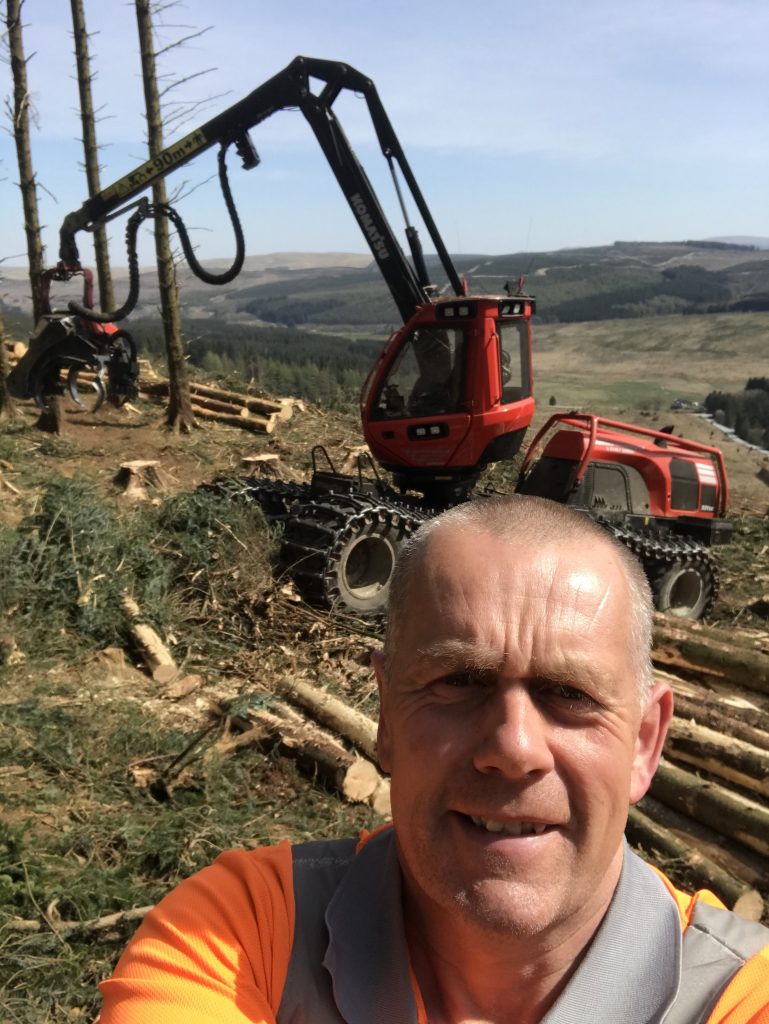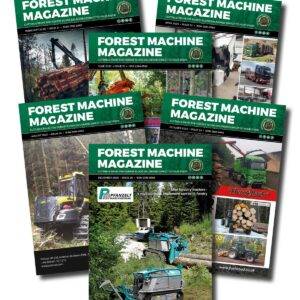Today’s harvesters are all very capable machines and all do a great job of harvesting the timber that this country needs. All manufacturers think that their equipment is better than their competitors, but in truth some machines are more suited to certain types of conditions than others.
This feature isn’t about comparing one make against the other, the intention was for honest and open feedback from operators.
Anthony Carr interviewed a random selection of UK operators who have used their harvesters for a considerable length of time and are in a position to offer their opinions.
Today we take a look at the Komatsu 931XC which is operated by Keith Palmer of Blacklock Harvesting.
The Komatsu 931XC is an 8WD harvester with an AGCO 251 hp EPA Tier 4 Final and EU Stage 4. 6-cylinder turbo diesel motor. The modern engine reduces noise thanks to its intelligent variable fan control.
The 931XC stands at 2996mm wide with 710 tyres. It has 710mm ground clearance, a steering angle of +/- 40° and weighs approximately 21,000kg depending on harvesting head.
This harvester features a type of double suspension. The articulated joint and a swing axle, along with the cab’s tilt cylinders and Comfort Bogie, lowers the machine’s centre of gravity and increases ground contact for added stability. The working hydraulics have a dual load sensing system with variable piston pumps offering a flow rate of 528 l/min @1600rpm with 280 bar.
Seven different Komatsu harvesting heads are available for the 931XC and three side mounted crane reach options with 8.7m, 10m and 11m reach.
The MaxiXplorer and Information system is a fully integrated CAN-based machine control system.
MaxiXT Control
The MaxiXT Control and information system controls the head, crane engine and transmission for optimum performance and economy.
Komatsu machines are MaxiFleet ready which makes it possible to monitor production and machine information, see each machine’s status, localise all machines, coordinate/optimise the machines and conduct proactive service measures.
The MaxiXl gives you full overviews on your smartphone, tablet, or your computer back at the office.
Keith Palmer
Keith spent his early years driving Lorries around the Scottish Borders area before operating a forwarder for two years for Robert Lawson. He then spent 6 months forwarding for Ian (tiny) Elliott before joining Blacklock harvesting where he has remained for the last 18 years.
“Overall performance of the 931 is excellent” said Keith. “Stability when reaching out on steep ground is very good, I put this down to the centre of gravity of the machine being very central. The climbing ability of the machine has been impressive”.
Keith regaled me with the time he reversed up an exceptionally steep slope with the crane and cab turned round with the head hanging over the back of the machine for added traction!
The machine copes with soft ground without any issues. Keith has been working a difficult site at Cardrona which includes gullies and steep ground. Average tree size on the site is 0.5m³ with Keith producing 28m³ per hour and the machine using 19 litres of fuel per hour.




Base Machine
“The frame brake on the 931 utilises a ram on either side of the chassis, when coupled with the 8 wheels it provides faultless stability even on steep slopes. Refuelling is accessed via a removable step which clicks into place to allow access to the fuel and Hydraulic filling points.
One issue I have though of is that when checking the Hydraulic oil level, I have to remove the bonnet protection bars before lifting both bonnets to see the sight glass – a hole cut in the side of the bonnet would be an easy solution. “
“The autolube greasing system takes care of most of the base lubrication with four greasing points on the main slew bearing and two on the driver’s access step being the only ones needing to be greased manually”.
The hose layout on the base machine is generally good, the only problem is in the centre joint where the hoses go under the cab which has resulted in a water hose failure. Storage is good with room for the toolbox etc in the front step although extra storage can be obtained by taking the plastic urea tank out which leaves room for hoses.
Cabin
After year’s operating Komatsu 941’s, Keith went on to operate a different make of harvester for about two years. He found the computer a little bit difficult to use at first but became used to it over time. Now back on a Komatsu it has taken time getting used to the 931 XC computer. He is now however, comfortable with it and say it is very user friendly. “Cabin comfort is excellent with the overall stability of the machine keeping things steady, along with a roomy cab and excellent seat. The levers are the wooden Komatsu ones but I find these better to use than the mini levers I have used in the past, I find them really comfortable with the buttons just where they need to be.”
“Storage inside the cab could be a lot better, if I put anything in the nets in the door they fall out when I shut the door. The two pockets behind the seat provide some storage but things rattle around in them so much that they are very annoying. Vision is excellent which really maximises performance, the only slight problem being if a tree gets caught in the crop on my right-hand side there is a blind spot due to the main boom. “
“However I can feel when the tree is caught so this doesn’t cause me any major problems. Levelling is excellent on steep ground and it levels further than machines I have operated in the past”.
The cab has courtesy lighting which gives a red glow around the cab while operating in the dark with the lights becoming white when the door is opened. Cabin greasing is part of the autolube system which would probably last for two weeks, but is filled up weekly to keep things running smoothly.
Crane
Although the main lift is perfectly fine, working close to the crop gives the best results. One thing Keith did remark on was, when handling large trees, a full diesel bowser or site safe, he has to be careful that the head doesn’t come in and hit the front of the machine due to lack of power in the dipper ram. “Slew power is good as is the extension” said Keith. “The machine stays stable even at full reach out to the sides”.
To keep the crane working at an optimum Keith calibrates the levers and all the functions on the crane at least once a fortnight, this is all done within the computer which is relatively straightforward to do.
“The Hose layout on the crane is generally good. The one hose I have had problems with is the one that houses the electric cable down to the head. This problem occurs while working on steep ground as it causes an acute bend on the hose where it goes into the electric box. With 4 lights underneath the main boom and 4 on the side of the crane it provides excellent lighting”.
C144 Head
“Felling with this head is good as the well designed saw box enables me to cut the stumps low. I fell the trees manually in larger crops and use fully automatic when I am in smaller stands. One short press of the saw button is all that is needed to cut all the way through in the fell cut; this can be overridden by simply pressing the button again. Feeding is excellent it has a good grip on big trees and accurate measuring is achieved when care is taken with big butt logs. On the rougher trees I am able to feed the tree all the way to the tip and then back to the butt with no loss of grip. The head is able to de limb rough trees but I tend to leave them for the cutter so as not to put too much strain on the head”.
Keith uses the semi-automatic method of cross-cutting, holding his finger on the saw button before the tree reaches its length which results in instant cross-cutting.
“The measuring is good on this machine. There have been problems in the past with Komatsu machines but I feel that they have it right now. Calibration is done via callipers every 1000 m³ which are very easy to use.
“Very Quick when the bar and chain are 100 %” were the words Keith used when describing the saw, and he added even when the chain goes dull it still cuts reasonably well but he doesn’t recommended this as it causes excess wear on the bar and chain. Chain snapping is minimal with the only slight problem being the chain sometimes catches the side of the saw box.
This Head has done 3500 hours. The only hoses that I have had to change were two knife hoses which had not been crimped properly when new. The feed roller hose layout is perfect unlike other heads I have used in the past. Greasing on the head is well thought out with the inner greasing points all accessed via a bank on the outside of the head with the other ones easy to locate”.
Final Points
Chain oil usage
About 5 litres a day.
Low Loader
“The machine is easy to put on the low loader. Folding the lights on the cab forward, and moving the lights under the main boom to the side, give the only minor gripes to folding the machine up for transport”.
Reliability
“Overall the C144 is a good reliable head.
Forest Machine Magazine is written and edited by a forest professional with over 40 years hands on experience. We are dedicated to keeping you informed with all the latest news, views and reviews from our industry.
To support us you can subscribe to our bi-monthly magazine which is delivered to your door from only £30 per year.
Subscribe here
#homeoflogging #writtenbyloggersforloggers #loggingallovertheworld





[…] READ MORE: Komatsu 931XC Harvester Report […]